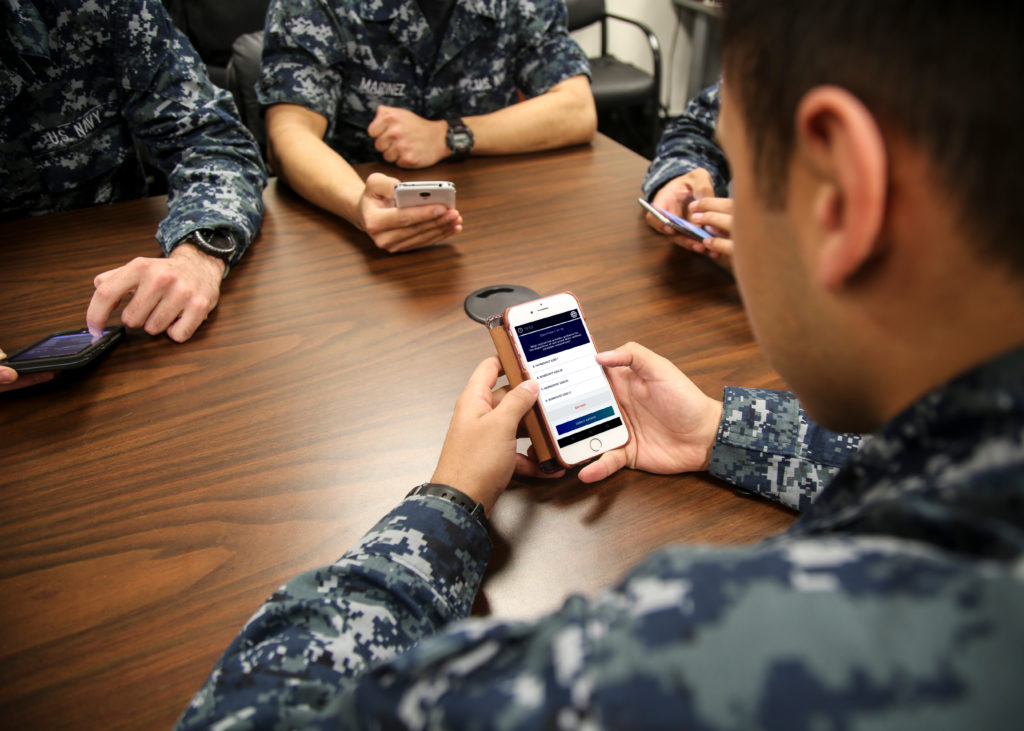Managing and Mastering Your Learning Style

.
Tell Me about Learning Styles
Welcome to Bluejacketeer! We are here to help you advance. Everyone who comes to our platform has a very unique way that they learn. That learning style is just as individual as each and every person who signs into this app. Even though there is a crazy mixture of different ways every individual absorbs information, these styles can actually be broken down into seven general categories. The first five categories are the Visual Learner, Auditory Learner, Reading & Writing Learner, Tactile (or Kinesthetic) Learner, and Mathematical/Logic Learner. There are also two subcategories, which are the Social Learner and the Solitary Learner. A person will fall into one of these two categories, regardless of which of the above five they lean toward. The better you know your learning style, the better you will be able to use Bluejacketeer and gain the advantage in the next exam cycle.
.

.
If you’ve taken advancement exams when you’re not sure of yourself, when the quotas are low, or when you’re striking for a new rate, you know that it can be quite a challenge. You know frustration of studying for hours on end, only to find that you still have not grasped the concept you’re attempting to learn. It just doesn’t seem to click. Regardless of how many times you repeat the information, you just don’t get it. This can be a sure sign that you have a specific learning style, but you just haven’t found it yet.
Read through all of the learning styles with the understanding that, while you may have a dominant style, you may still have another, or even a combination of styles that are simply used less often but are worth incorporating into your study routine. Knowing this unique mix is a valuable key that unlocks your own unique way of learning.
.
Visual Learner
If you learn visually, you simply take the most advantage of what you see. For instance, any resources that offer illustrations, diagrams, charts, handouts, and video content will all be very beneficial. Given the option between visual presentations and written information, you will always prefer the visual option. You have a particular appreciation for art. You can memorize information if you see it. At the same time, you might grasp the big picture, while having trouble understanding all the minute details that go along with it. This type of person is often gifted in emotional, spiritual, and creative arenas, but can have a hard time learning to read, write, and spell. If you learned to read and write using phonics, this may have been more challenging for you, as phonics is geared to a more audio-based learning style.

If you are a visual learner, vocabulary words often cement into your memory, especially when you have the opportunity to draw pictures alongside them, as a representation of what the word brings to your mind. In much the same way, using or creating diagrams can help you remember numbers and formulas. You’ll find you are better at keyboarding than writing with a pen or pencil. Right answers come to you without you even being able to explain the process you used to arrive at that answer. Still, your vivid imagination and ability to think outside the box can make you great at processing information in a new way.
If you are a visual learner, you find that you use colored pens or paper to differentiate between points or topics when writing or doing other projects. Illustrated flashcards work well, as do PowerPoint presentations and other forms of visually stimulating media. When using a textbook, give yourself a head start by scanning over titles, pictures and charts so that you can have that visual foundation when you begin to read.
Choose your study material from something that has a graphic appeal. Photography, architecture, video, and computer design can all be excellent tools for you as a visual learner. Color coding is a great way to maintain order and organization, especially while writing. Word lists should be created with unique colors so that they stand out to you by topic or specific subject matter.
The Visual Learner’s study area should consider the following:
- Set aside a space
- Limit distractions
- Choose colorful learning material
- Take thorough, colorful notes
- Doodle images and concepts
.
Auditory Learner
As an auditory learner, you capitalize on information that is processed by hearing it, and you usually think in words instead of pictures. You often remember very well what you are told and then retain most of the information you hear during a lecture. If given the opportunity, you would rather listen to the lecture rather than watch a video or read a transcript of it. Reading out loud helps you to memorize information, and reviewing podcasts works better than reviewing written notes. One way to tell if you’re an auditory learner is your inability to read facial expressions or body language well.
If you can pair music with the facts you are studying for an exam, you will usually respond well when test time comes around. In fact, an auditory learner usually has at least some degree of musical talent, having the ability to hear notes, tones, and rhythms and to quickly memorize the lyrics of their favorite songs. You might often find yourself reading aloud in private as you try to make sense of something you’re learning. You tend to be good with language and to think conceptually and abstractly.
If you can pair music with the facts you are studying for an exam, you will usually respond well when test time comes around. In fact, an auditory learner usually has at least some degree of musical talent, having the ability to hear notes, tones, and rhythms and to quickly memorize the lyrics of their favorite songs. You might often find yourself reading aloud in private as you try to make sense of something you’re learning. You tend to be good with language and to think conceptually and abstractly.

Your studying should take place in areas that are quiet and do not have a lot of television or background conversation. For an auditory learner, this audible chaos can blast right through your concentration, making it almost impossible to study. Using a recorder of some sort for recording reading materials or lectures can also be helpful, as can speaking and recording the answers to the exam questions. You will be very attentive to details, but you may also learn best by trial and error. Debates, oral presentations, and social discussions are all strong points for you as an auditory learner.
To establish your foundation, read your topics and headlines aloud when you begin to study. This will get your full brain into study mode. Verbally brainstorming activities or having someone question you will help to pull out as much information as possible.
Here are a few tips for the auditory learner:
- Minimize auxiliary noise
- Talk through your studies
- Use a narrator app to go through bibs
- Use music
- Turn information into rhymes or songs for better memorization
.
Reading/Writing Learner
Words in and of themselves mean a great deal to you if your learning style is reading and writing. You find that you are excited to be able to read through a textbook instead of listening to someone rattle off information. You may take a lot more notes in comparison to those who learn differently. You enjoy definitions, lists, handouts, and projected text, retaining much of that information in the form of words in your mind for future use.

It won’t be out of the ordinary for you to seek out information through articles and internet searches. In fact, research and essay writing are things you have likely excelled at in the past. You may read through the PDF versions of the bibs just for fun, and you easily absorb your study material this way. Furthermore, if you have an opportunity to write down what you have learned, this often gives you a much clearer picture of what you have studied.
To get the most out of your reading/writing learner time:
- Set aside plenty of independent study time
- Have note-taking material handy
- Make use of the PDF version of the bibs, as well as other reference material
- Write out challenging questions (Note/index cards)
.
Kinesthetic Learner
If you are a kinesthetic learner, you learn through tactile stimuli such as by touching, walking, and/or organizing visuals. You will exhibit more information retention by touching things and doing something physically while learning new information. A hands-on experience is most effective for you; you choose to learn by the trial and error of actually doing. Physical activity is important to you. Depending on your rate or NEC, develop creative ways to incorporate your learning style into your study. When you do, you may find them to be not only more interesting, but you will also be better able to remember them when exam time comes.
Kinesthetic learners are, by nature, very fidgety, and aren’t able to sit still for very long. You need to keep moving while you study. Sometimes, it could be as simple as walking back and forth while reading, which can help you retain the information accurately and more quickly than simply learning while sitting still or remaining stationary.

For you as a tactile learner, activity aids in memorization. Study while doing something active. For example, bouncing on a small trampoline might help you remember acronyms! Sitting still, quite to the contrary, makes it harder for you to pay attention, so retention of any information taken in this way is often not easily recalled, if it can be recalled at all. Have a pen in your hand or a fidget spinner. Roll your skateboard under your feet while studying. Doodle as much as you like while taking notes, because you are forming a connection between what you’re learning and what you’re drawing.
You can tell if you are a kinesthetic learner because you may assemble things that come in pieces with no need to read directions. Instead, you capitalize on any pictures or diagrams that are included or move the pieces around and discern where they belong.
Preparing the Kinesthetic Learner’s environment:
- Doodle test figures while you study
- Walk, tap your feet, snap your fingers, etc
- Act out any possible quiz question or concept
- Take more breaks, then get back to it!
.
Mathematical/Logical Learner
If you are a logical learner, you enjoy solving problems, working with abstract visual topics and working with numbers, which is surely no surprise to you. As a methodical thinker, you quickly recognize patterns in a variety of items and concepts, and you can analyze them with ease. Grouped information is easier for you to grasp, and it often surprises people that you can figure out complex calculations in your head. Itineraries, agendas, and to-do lists have always come easy. You enjoy games that give your mind a healthy workout, such as trivia, brainteasers, and chess.

You have thrived with one-on-one instruction because your questions are deep and detailed, which means that you have required specific, individualized attention. This is not only a learning style, but a lifestyle for a logical learner. You use this kind of reasoning to think about, figure out, and describe almost everything, including original thought processes and emotion. You are an excellent problem solver with a keen eye for visual analysis, and you will constantly attempt to find new, structured, and logical ways of expressing yourself. It’s not hard for you to tell that something is “off” if the information is incomplete or if it is missing a crucial piece. This is why you should study in a very controlled environment so that you’re not forced to analyze something unfamiliar in your surroundings.
The mathematical/logical learner’s environment is greater than or equal to this:
- Study in a familiar environment
- Consistency is very valuable
- Gamify your study
- Use flash cards and time yourself
- Compete with another person
.
Social Learner
Social learners are excellent at communicating with people. This communication can be verbal or nonverbal. You are incredibly sensitive to emotion, moods, and motivation factors. You do well in groups and are often sought out for advice when one of your friends can’t decide what to do about a problem. At the same time, you enjoy the opportunity to share your ideas and get feedback from others with whom you have shared. For you, studying in groups is ideal.

Social learners are responsible for the term “social butterflies,” and that’s just what you are! You enjoy any activity that includes multiple people, including sports, board games, theatre, and musical performance. You enjoy simply being with and interacting with others, especially friends and family. Counseling, mentoring and helping others come naturally and you often have strong empathy for others.
The designation of yourself as a Social Learner is a secondary learning style. To find out what your primary learning style is, you’ll need to consider the first five listed in this guide, as one will emerge as dominant, even with your outgoing personality.
Your social learner enjoys success in this environment:
- Music playing
- Gamify with others online
- Study in groups in person
- Make time to chat with someone about what you’ve learned
- Study with other social learners who share your primary learning style
.
Solitary Learner
Also called an “intrapersonal” learner, you prefer your own space for learning. You also have a great level of self-motivation, do your best work when left alone, and truly enjoy your independence. A quiet environment is often your best friend, both in personal and academic settings. You are likely to be very uncomfortable in noisy, crowded situations. You may struggle with the ability to self-manage and aren’t quick to share your feelings with anyone, but you do have a very independent mindset and make lots of big plans.

Solitary learning, in and of itself, isn’t a primary learning style, but rather a secondary one. To find out what the primary learning style is, you’ll need to consider the first five listed in this guide, as one will emerge as dominant, even with your introverted personality. Learn to allow for yourself plenty of peace and quiet. Your intrapersonal personality makes it hard for you to ask for your help. Sometimes, you won’t even admit a problem exists, even when there is one. Knowing this can give you the edge over others like you. Take advantage of the knowledge and force yourself to reach out.
Your solitary learner environment looks like this:
- Quiet and alone
- Time for introspection
- Give yourself permission to need help
- Set goals, especially for review and instruction if needed
- Take a break in your favorite quiet location
.
Online Resources
As an exercise in studying and/or discovering your specific learning style, consider the digital resources available to us for learning and entertainment. Ask yourself “What do I gravitate to when I’m trying to learn or better understand something?” Do you go watch a YouTube video? Do you pick up a good old-fashioned book? Do you use Audible? Or do you gamify, using your hands to click and choose answers?

Now that you have determined what your favorite resources are, what does this tell you about the learning category that you fall into? Custom design your learning so that you get the very most out of your unique recipe of learning styles.
.
In Conclusion
Most people tend to teach in the same style in which they themselves learn. In other words, a visual learner will naturally teach visually, a kinesthetic learner will naturally teach kinesthetically, and so on. Now that you have a better idea of your own learning style, take ownership of how you learn. Build in the specifics of your learning style within whatever opportunity you have in front of you regardless of how it’s presented.
This guide is going to give you an advantage over others who are competing for your position. Now that you know your learning style, even if you go head-to-head with another person with that same learning style, here you have learned tools that will give you the edge over that person.
Bluejacketeer is continually looking for ways to accommodate all learning styles. Watch for revisions in our free companion mobile app as we continue to improve our services to the U.S. Navy Sailor.